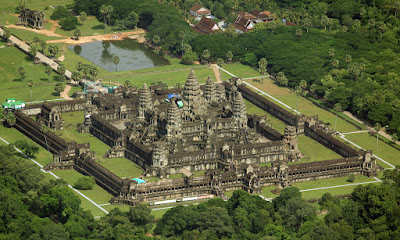The Top 10 Most Beautiful Temples in the World
They are must-see spots for a good reason, as they are some of the most beautiful and amazing structures ever created. Here is a list of the top 10 most beautiful temples in the world.
1. Wat Rong Khun, Thailand
This is a Buddhist temple that combined traditional designs of the religion with modern and contemporary art. The entire temple is painted in white, as white represents the purity of Buddha. Almost all the decorations are in white as well, though there are sprinklings of gold in illustrations that show the escape from the darkness of temptation to the attainment of the divine. The temple also features several pieces of reflective glass, as it symbolizes the infinite wisdom of Buddha that lights up the entire universe. The glasses also serve a dual purpose because the reflection gives the temple a spacious.
2. Angkor Wat, Cambodia
This Buddhist temple was built by the Khmer civilization. It is considered to be one of the masterpieces in the field of architecture in the world. This unique temple actually has three levels. In the center is the tallest tower standing at around 65 meters high. Four smaller temples surround this, with statues and bass relief of gods and deities spread all throughout. Angkor Wat is considered a center of the Buddhist faithful, and pilgrims flock to the temple every year. It has also become a popular tourist spot.
3. The Golden Temple, Punjab, India
An artificial island in Punjab in India served as one of the favorite meditation places of Buddha. A founder of another religion, Guru Nanak of the Sikh faith, also used the place to quietly contemplate. The Golden Temple of the Sikh religion was built on this island and this serves as their spiritual center. It features a Mirror Room that is decorated with stately symbols shaped like an umbrella. It is located in a pavilion topped by a dome. The 16th century structure also contains the Sikh bible called the “Grant Sahib.” This, in turn, is kept under a gold canopy decorated with precious gems.
4. Prambanan, Indonesia
This Hindu structure was built in the 10th century and aimed to show the triumph of the Hindu religion in Java Island in Indonesia. It stands at 47 meters high and features three buildings, one each for the three gods, namely Vishnu, Brahma and Shiva. The temples all face to the east, a direction that is considered sacred. There are 250 smaller shrines that further surround the temples. Each one is decorated with natural ornaments and parts of the sacred book called “Ramayana.”
5. Sri Ranganathaswamy Temple, India
This Hindu temple is located in the Srirangam district of Trichy. It is considered to be one of the most important temples to Vishnu in the world. The temple is actually dedicated to the god Ranganatha, a form of Vishnu that opens to listen to the prayers of and blesses his worshippers. It is located in a swath of land measuring 156 acres and it features a tower that stands 236 feet. Colorfully painted towers adorn the shrines.
6. Shwedagon Pagoda, Myanmar
This gilded monument to Buddha rises to a height of 98 meters and features golden decorations that weighs nearly nine tons. It has frescoes with mythical beings and impressive statues. The pagoda towers above the entire capital city of Myanmar, situated just west of the Kandawgyi Lake. It contains the relics of four Buddhas and eight pieces of hair from the head of the Buddha.
7. Tiger's Nest Monastery, Bhutan
This Buddhist temple is where Guru Rinpoche, also known as the Second Buddha, was said to have meditated. The temple boasts of outstanding architecture and amazing beauty. It is located in the Himalayas on high cliffs above the Paro Valley. Guru Rinpoche was said to have appeared while riding a flying tiger. He then retreated to this place to mediate and subjugate the evil spirits trying to conquer his will. It is now considered to be one of the most sacred places in Bhutan. The temple also offers an astounding view of the surrounding areas.
8. Borobudur, Indonesia
This temple is built in the form of a lotus that can float in a large lake, similar to which Buddha was born. The temple is located in Central Java. It was abandoned a thousand years ago, eventually being consigned to the dustbin after it was covered with ash after the eruption of the Merapi Volcano. The temple, however, was rediscovered in 1814. Considered to be a monument to world heritage by the UNESCO, the temple features a large stupa bell that the faithful call the Sacred Lotus. There are 504 Buddha statues that adorn the place. It is considered to be the largest and oldest Buddhist temple in the world.
9. Temple of Heaven, China
This temple was built more than five centuries ago by the Ming Dynasty to honor the sky. It stands in a vast tract of land measuring 2.7 million square meters. It is divided into an inner and an outer part. It also has a rectangular southern wall that symbolizes the earth, and a circular northern wall that represents heaven. It is considered to be a historical and cultural landmark of China.
10. Jetavanaramaya, Sri Lanka
This is a stupa located in the ruins of the Jetavana Monastery in Anuradhapura, a sacred world heritage city. It represents the tensions between the Theravada and Mahayana sects of Buddhist monks. It was one of the tallest structures in ancient times. A part of a sash or belt that was used by Buddha is enshrined in this temple.

























































